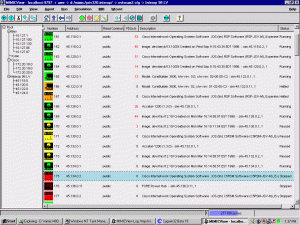SNMP (Simple Network Management Protocol) consists of three crucial components: managed devices, agents, and NMS (Network Management Systems). A managed device is a node which is required to be monitored and managed. It has an SNMP agent software running on it. These devices can be routers, switches, bridges, computer hosts, printers or hubs. An agent is an application unit residing inside a device and keeps track of all the device activities. This agent interprets data into a compatible format with Simple Network Management Protocol. A Network Management System is an application that manages all nodes by communicating with the SNMP agent..
Simple Network Management Protocol – a closer look at the MIBs & OIDs:
MIB (Management Information Base) is a set of data, which’s hierarchically organized. The different pieces of data are accessed by SNMP protocol. There are two kinds of MIBs: scalar and tabular. Scalar objects delineate a single object example while tabular objects delineate multiple related object examples collected in MIB tables.
 OIDs (Object Identifiers) uniquely recognize managed objects in an MIB ladder. It can be represented as a hierarchy whose nodes are allocated by diverse organizations. Usually, an OID is a long cycle of numbers, coding the nodes, divided by dots. Top level MIB object ODIs belong to diverse standard organizations. Seller delineates private branches comprising managed objects for their personal products.
OIDs (Object Identifiers) uniquely recognize managed objects in an MIB ladder. It can be represented as a hierarchy whose nodes are allocated by diverse organizations. Usually, an OID is a long cycle of numbers, coding the nodes, divided by dots. Top level MIB object ODIs belong to diverse standard organizations. Seller delineates private branches comprising managed objects for their personal products.
MIBs, OIDs and instances:
MIBs are set of definitions, which delineate the properties of the managed object inside the device to be directed. For instance, the standard objects to screen on a printer are the diverse cartridge states and possibly the sum of printed documents, and on a switch the distinctive objects of interests are the incoming and outgoing traffic and also the volume of package loss. Each managed device maintains a database of values for each of the characterization written in the MIB. Therefore, the accessible data is actually not reliant on the database, but on the execution. Each retailer of #SNMP tool has their appropriate segment of the MIB tree configuration at their disposition.
To arrange all these appropriately, all the controllable features of entire products are organized in this MIB tree configuration. Every ‘branch’ of this tree has a number and a name, and the total path from the zenith of the tree down to the point of interest outlines the name of that point. This total path is the OID. Nodes close to the zenith of the tree are of general nature. For instance, to acquire the Internet, one requires arriving at the 4th node of the Object Identifier. When the user move further down the tree, the names get more precise, until he/she gets to the foot, where each node depicts an exact feature on a particular device.






0 comments:
Post a Comment